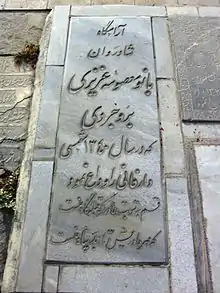Mahvash
Mahvash (Persian: مهوش), born Masoumeh Azizi Borujerdi (Persian: معصومه عزيزى بروجردى), was an Iranian singer, dancer, film actress and stage performer.[1] She came from a poor family and was lauded as a singer (performer) of the people in the 1950s.[2]
Mahvash مهوش | |
|---|---|
 | |
| Background information | |
| Birth name | Masumeh Azizi Borujerdi معصومه عزيزى بروجردى |
| Also known as | Mahvash Akram, Banu Mahvash, Ma'sumeh Azizi Borujerdi, Akram Ābgūshtī |
| Born | 1920 Borujerd, Sublime State of Persia |
| Died | 1961 (aged 40–41) Tehran, Imperial State of Iran |
| Occupation(s) | Singer, dancer, stage performer |
| Years active | 1950–1961 |
Early life and early career
Mahvash was born Masoumeh Azizi Borujerdi in Borujerd, Iran to a poor family, when Mahvash was a teenager the family came to Tehran. At an early age, Mahvash lost her mother. Later she went on to perform in Tehran's cabarets (Persian: kafe-i motrebi) and cafes in the late 1940s to early 1950s and drew large support from the working people.[3]
However, there is confusion around her biography, and different accounts of what type of performances were happening at this age and where.[4] The most common story is that she performed risqué songs in the cabarets, on the radio and in movies.[5] Another prevalent story is she began in a classical ruhowzi dance troupe as a dancer, pishparde singer, and actress;[3] and she married a violinist who secured her entertainment engagements.[3]
Career
She gained the admiration of the masses’ by articulating in her songs the problems, difficulties, and frustrations of the common people, struggles which she knew very well.[1][6] Her most famous songs involved a call and response-style singing with her male audience.[5]

She published a book in 1957 which she termed an "autobiography" which was entitled Secrets of Sexual Fulfillment (Persian: Raz-e Kamyabi-ye Jensi). This book was more of a sex manual had pictures of her in a bathing suit and was published and widely distributed despite being prosecuted for the book in June 1960.[5] It seems that Mahvash's ability to speak to the marginalized majority absolved her of her forays into prostitution and other publicly indecent behavior.
When Mahvash died in a car accident in 1961, her public funeral went down in Iran's history as the largest of its day, with thousands of Iranians on the streets to mark her passing.[2] Iranian religious authorities were unwilling to accept burying her in a Muslim cemetery because as an entertainer she was considered "unclean" and "unchaste",[5] however when the large amount of mourners celebrated her passing they relented.[5]
She is buried in the Ibn Babawayh Cemetery in Tehran.
Filmography
Acting
- 1956 – The Sun Shines (Persian: خورشید میدرخشد, romanized: Khorshid Miderakhshad), with director Sardar Saker[5]
- 1956 – Layla and Majnun (1956 film) (Persian: لیلی و مجنون, romanized: Leyli va Majnun), with director Ali-Mohammad Nourbakhsh[7]
- 1957 – Ladder of Progress (Persian: نردبان ترقی, romanized: Nardebane Taraghi)
- 1957 – The Happy Naked One (Persian: برهنه خوشحال, romanized: Berahneh Khoshhal), starring with Mohsen Mahdavi[8]
- 1959 – A Girl from Esfahan (Persian: دختری از اصفهان, romanized: Dokhtari az Esfahan), with director George Ovadiah
- 1959 – Two Brides for Three Brothers (Persian: Do Aroos Baraye se Baradar), with director Mohammad Abdi (film director)[7]
- 1961 – What's the Difference (Persian: Ki Be Kiyeh), with director Reza Karimi[7]
References
- Matthee, Rudolph (Rudi); Baron, Beth (2000). Iran and Beyond: Essays in Middle Eastern History in Honor of Nikki R. Keddie. "Voices Unveiled: Women Singers in Modern Iran,” Chehabi, Houchang E. Costa Mesa, Calif.: Mazda Publishing. ISBN 1-56859-099-7. Retrieved October 17, 2014.
- "Big Girl, Iran's Mahvash". Six Pillars. April 24, 2013. Retrieved October 17, 2014.
- Breyley, G. J.; Fatemi, Sasan (November 19, 2015). Iranian Music and Popular Entertainment: From Motrebi to Losanjelesi and Beyond. Routledge. pp. 68–69. ISBN 978-1-317-33680-8.
- Breyley, GJ; Fatemi, Sasan (2015). Iranian Music and Popular Entertainment: From Motrebi to Losanjelesi and Beyond. Routledge. ISBN 978-1317336792.
- Naficy, Hamid (September 16, 2011). A Social History of Iranian Cinema, Volume 2: The Industrializing Years, 1941–1978. United States: Duke University Press. ISBN 978-0822347743.
- Talattof, Kamran (June 1, 2011). Modernity, Sexuality, and Ideology in Iran: The Life and Legacy of a Popular Female Artist. Syracuse University Press. pp. 101–102. ISBN 978-0-8156-5139-0.
- "Mahvash". Soureh Cinema. SourehCinema.com. 2013. Retrieved October 17, 2014.
- "Nostalgia". Iranian.com.